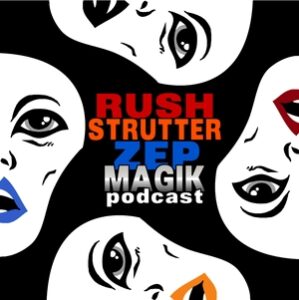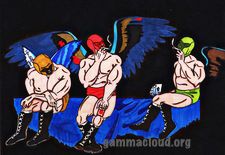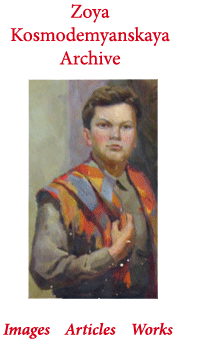[Revised February 2016]
For many years now, I have kept a special spot reserved in my living space to display my favorite comics of all time. Years ago, I had a prominent display of my eight favorite comics, then I added two more to make it my “top ten.” These days, I have a little more living space and a couple more favorites, so now I have a “top fifteen” section on the wall of my home library. Here’s a bit about the books that make up my “top twelve” including why I think they are all so great.
Because I complain from time to time about how inaccurate and annoying those “best of” lists can be, I must preface my own list by acknowledging that these comics are simply my own favorites and I am not suggesting they are the best of the best or anything like that. Some of my picks are among the most renowned of the silver age classics and some of them are rather obscure. Whatever the case, they are all well-read and the are the best-loved of my small collection. Onward…
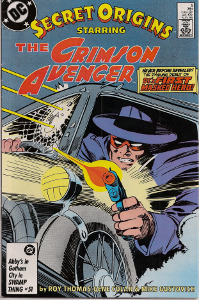 Number 15: Secret Origins #5
Number 15: Secret Origins #5
“The Crimson Avenger” (DC Comics, August 1986)
This issue offers a post-Crisis, retconned origin of the Crimson Avenger, a masked hero in the tradition of The Shadow and The Green Hornet. The tale, which is actually the first-ever origin tale spun about the Crimson Avenger, is set against the 1938 broadcast of The War of the Worlds, with some of the events happening in sync with the ensuing panic caused by the radio show. It’s also dedicated to the memory of Orson Welles, who had passed away in 1985. The story is masterfully told by Roy and Dann Thomas featuring pencils by Gene Colan.
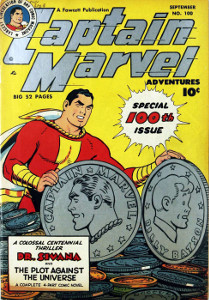 Number 14: Captain Marvel #100
Number 14: Captain Marvel #100
“The Plot Against the Universe.” (Fawcett Comics, Sept. 1949)
In this issue’s main tale, Captain Marvel invents/discovers three new “elements” and adds them to the Periodic Table while battling Dr. Sivana for the fate of the entire universe. I first read the story when I was about 12 years old in The Smithsonian Book of Comic Book Comics and then decades later as an adult, I finally found an original copy of the issue itself as a comic con. This book has the distinction of one of the most expensive books ever added to my collection (I won’t say how much I paid but I had a lot more disposable income back then). I’m told that the silver-colored ink used on the cover was very rare at the time this book was published.
 Number 13: Marvel Super Heroes Secret Wars #12
Number 13: Marvel Super Heroes Secret Wars #12
“…Nothing to Fear” (Marvel Comics, April 1985)
This issue marked the conclusion of Marvel’s legendary limited series in a most dramatic fashion. Written by Jim Shooter, the story begins with a shocking scene as the entire cast of heroes lie dead, blown to pieces by a “bolt from the blue.” The heroes lie dead, killed by Doctor Doom who recently acquired the omnipotent powers of The Beyonder. By the end of the tale, the Beyonder cleverly tricks Doom into giving his omnipotence back, the heroes rise again and all live to battle another day.
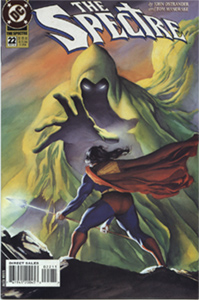 Number 12: The Spectre #22
Number 12: The Spectre #22
“Spear of Destiny, Conclusion” (DC Comics, September 1994)
A great cover and a great story! This issue, written by John Ostrander, concludes a 4-issue story in which The Spectre battles the elemental known as Naiad. The US Government, fearing an alliance between The Spectre and Naiad, enlists the help of Superman who is entrusted with the legendary Spear of Destiny to use as a weapon against The Spectre (The Spear of Destiny will be an integral part of another “top twelve” story as well). On the way to join The Spectre and Naiad in battle, Superman becomes possessed by the power of the spear and goes on a maniacal rampage, crushing all who oppose him. In the end, the only thing that stands in between Superman and world domination is The Spectre himself. Cover art by the incomparable Alex Ross.
 Number 10: Watchmen #11
Number 10: Watchmen #11
“A Stronger Loving World” (DC Comics, October 1987)
Most comics fans probably agree that Alan Moore’s Watchmen miniseries changed the face of comics. The 12-issue limited series ran from 1986 to 1987 and was set in the heady days of the Cold War amidst the threat of imminent nuclear Armageddon. Moore’s Watchmen tells the tale of how the world might have evolved had super heroes really existed, exploring their likely roles in politics and war.
The story is likely one of the most complex and multifaceted tales to have been portrayed in a comic book format at the time of its publication. Along the way, Moore introduces readers to some of the most amazing and intriguing characters in comics history, including the likes of Rorschach and Dr. Manhattan.
Issue 12 is, of course, the final chapter in the series. One might think that the conclusion of a story would generally tie up most of the loose ends. But Watchmen really did break most of the rules in the comics world and the conclusion of the story is certainly no exception. Readers are left with a host of questions and moral dilemmas on a scale so vast that it’s simply impossible to do the tale any justice whatsoever with a short and simple summary.
The complete Watchmen series is available as a one-volume trade paperback. If you have read this far and you don’t already own a copy of the book, you should probably go ahead and buy it.
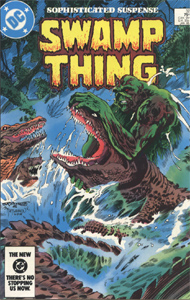 Number 10: Swamp Thing #32
Number 10: Swamp Thing #32
“Pog” (DC Comics, January 1985)
I had long considered this selection to be one of my “obscure” favorites, and perhaps it is relatively obscure compared to some of the other books in my favorites list. But I did a quick Google search before writing this piece and I was surprised to find that this issue won the Kirby Award for best single-issue story of 1985. It also seems to regarded as somewhat of a classic in its own right, even garnering a mention in the Wiki entry for “Swamp Thing.” So it seems as if plenty of folks out there have appreciated this issue at one time or another.
This is another Alan Moore work and once again, it is not a typical comic book story. The story is an homage to Walt Kelly’s legendary comic strip “Pogo” and it features a cast of Pogo-like characters and dialogue written in the Okefenokee swamp dialect (from the original Kelly strips). In Moore’s adaptation, “Pog” and the other swamp characters have fled their native planet after it was overrun by the intelligent but violent creatures known as “The Loneliest Animals.” With the help of Swamp Thing, “Pog” and the crew of his ship, Vivi-Quinquereme, soon learn that “The Loneliest Animals” — humans — also rule the planet of Earth. Heartbroken, “Pog” and his crew assemble to depart Earth and continue their quest, but not before one of the expedition’s crew meets an untimely and unfortunate demise.
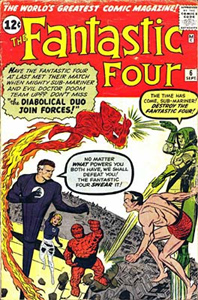 Number 9: Fantastic Four #6
Number 9: Fantastic Four #6
“Captives of the Deadly Duo!” (Marvel Comics, September 1962)
Sometimes I still can’t believe that I have a copy of this issue in my collection. This issue claims the title for the most money I have ever spent to purchase a single issue. I bought my copy the morning of my wedding day after having read reprints of the issue (in various formats) many times over.
This issue chronicles the first super-villain team-up in the history of the Marvel Universe, pairing the Sub-Mariner with Dr. Doom. Dr. Doom talks Sub-Mariner into attacking the FF at the Baxter Building, but Subby is double-crossed by Doom. Dr. Doom must then face the combined wrath of Sub-Mariner and the FF in a final battle in space.
The artist for this issue is none other than the incredible Jack Kirby.
Number 8: Crisis on Infinite Earths #12
“Final Crisis” (DC Comics, March 1986)
This issue is the final installment of DC’s groundbreaking limited series. This issue features the remaining heroes from the old Multiverse fighting side by side with the new heroes of the revamped DC universe as they do battle against the Anti-Monitor and his hordes of shadow demons.
The great thing about the Crisis series was the massive scale of the story itself. The ultimate goal of the series was to reconfigure the supposedly “confusing” continuity of DC’s parallel universes (known as the “Multiverse”) and pare everything down to one simple universe with a unified continuity. Hundreds of heroes and villains appear throughout the course of Crisis, some of whom vanish into oblivion while others survive — complete with new origins or a unified continuity based on their counterparts in parallel universes.
“Final Crisis” is full of surprises, including a temporary alliance between Rip Hunter (and other heroes) with the super-villains Brainiac and Darkseid. The final fate of the Flash (Barry Allen) is revealed to the heroes and other characters like Robin (Earth-2), The Dove, and many more meet untimely demises. Other important moments in the book include the team-up of all of DC’s occult heroes (led by Dr. Occult and Earth-2’s Green Lantern) and the final battle between the Anti-Monitor and Superman of Earth-2.
Crisis on Infinite Earths remains my favorite comics series of all time. Many characters and features from the plot of the series were ultimately revisited in DC’s long awaited sequel, Infinite Crisis.
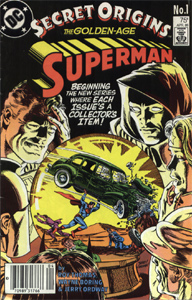 Number 7: Secret Origins #1
Number 7: Secret Origins #1
“The Secret Origin of the Golden Age Superman” (DC Comics, April 1986)
Of all the versions of Superman’s origin, this one is my favorite. This issue features a thorough retelling of the origin of Superman of Earth-2, also known as “The Golden Age Superman.” The tale is a post-Crisis version and it is told against the backdrop of the revised continuity of the DC Universe. The story successfully integrates the time-honored classics elements of Action Comics #1, along with Earth-2 stories from the 1960s and 1970s, and new material written specifically for this version. The issue was written by Roy Thomas and it features art by Jerry Ordway and Wayne Boring.
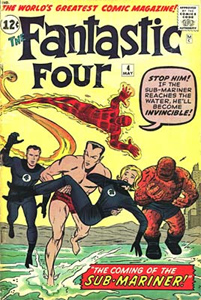 Number 6: Fantastic Four #4
Number 6: Fantastic Four #4
“The Coming of…Sub-Mariner!” (Marvel Comics, May 1962)
I can still recall where I was the first time I read a reprint of this issue—I was sitting in my 7th grade Pre-Algebra class. There was a special event going on that week called “Right to Read Week” and in many classes we simply had hour-long sessions of “sustained silent reading” (instead of our regularly scheduled lessons) in which we could read anything we wanted, with the exception of magazines and comic books. I would assume that I had a book with me that day, but I was apparently uninterested in it and I borrowed a digest-sized paperback volume of Fantastic Four comics from the guy that was sitting in front of me. When I say that it was “digest-sized,” I mean that it was indistinguishable from a regular paperback book, which allowed me to secretly read comics for the better part of an hour. The collection featured complete reprints of Fantastic Four issues 1 through 6 and this is where I first read this story as well as Fantastic Four #6, which was featured in an earlier entry of my favorites list.
This story chronicles the Silver-Age resurrection of Sub-Mariner. Early in the tale, Subby is found by Johnny Storm (aka The Human Torch). His identity is initially somewhat of a mystery as Sub-Mariner has fallen on difficult times. He is found wandering the streets of New York as a homeless man with no recollection of his past. With Johnny Storm’s help, Subby is cleaned up and his memory is restored. Sub-Mariner remembers that he is Prince Namor of Atlantis and he recalls that mankind is to blame for the destruction of his kingdom. He swears vengeance on all humans and he subsequently attacks the Fantastic Four. During the fight, Sub-Mariner develops a crush on FF’s Invisible Girl and although he decides not to vanquish them in this round, he vows to return someday as their greatest foe.
I bought an original copy of Fantastic Four #4 in 1992 or so for only $20. The current Overstreet value for a mint copy runs several thousand clams, so one can gather that my copy is not in the best of shape. The official grade for the condition my copy would likely be “Poor.” I haven’t removed my copy from it’s protective bag for over 10 years and doing so now would probably cause more damage than necessary, but if I recall correctly, my copy is complete and largely intact.
Whatever the case, FF #4 is a great read, regardless of the format or condition.
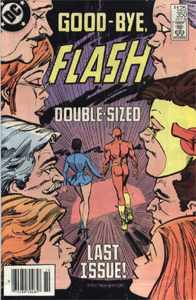 Number 5: Flash #350
Number 5: Flash #350
“Flash Flees” (DC Comics, October 1985)
Before I prepare each article for the “Mike’s Favorite Comics” series, I remove the featured issue from my “Wall of Fame” and give it a quick read before setting to work. I have read each of the comics in my “top 12” many, many times over but it’s always helpful to get re-acquainted before I try my hand at describing them for these articles. So I removed this issue from the wall one day and read through it for the first time in quite a long while. I hadn’t read this issue in years and the first thought that I had was that the issue doesn’t probably stand on it’s own as a phenomenal work in the annals of comic book fandom. But nevertheless, it is one of my personal favorites for a few important reasons…
The Flash (a.k.a. “The Silver Age Flash” or “Flash of Earth One” to you comic geeks…or, to the even geekier, we can refer to him as “Barry-Flash”) is my all-time favorite comic book hero. Let’s face it…Flash’s super-speed is probably one of the better super-powers to possess. Not only could Flash run really, really fast, but he could actually move so fast that he could defy gravity, travel through time and even vibrate his molecules so that he could pass through solid objects like buildings or the Earth itself. Flash even beat Superman in a foot race on more than one occasion. Flash also had some of the best arch-foes in the so-called “Rogues Gallery” of super-villains.
Flash #350 is the final issue of the Silver Age Flash series. This issue wraps up several long-running loose ends in the series, including the matters of Flash’s bogus conviction in the murder of Professor Zoom and the final fate of Flash’s wife, Iris West. The book also features an unprecedented team effort by Flash and the Rogues to defeat another of Flash’s greatest arch-rivals, Abra Kadabra. In the end, Flash is reunited with Iris and they go off to live happily ever after in the far-flung future.
A short time later (relatively speaking), Flash meets his final fate in the pages of Crisis on Infinite Earths #8. DC effectively “killed” this incarnation of the Flash off in this story and he has remained “dead” for over 20 years. DC basically took the stand that Flash (like Supergirl) was dead for certain after Crisis and that he would not be resurrected in the future. For a long time, I was resentful of the decision to kill off the Flash, as he was an integral character in the DC Universe for more than 30 years. But in retrospect, there has probably been some benefit to having Flash out of commission for all these years. In many respects, Flash has remained just as I remember him from the stories yesteryear and the old stories from the Silver Age up through the mid-1980’s have fantastic qualities that make them superior to many other comics from that era.
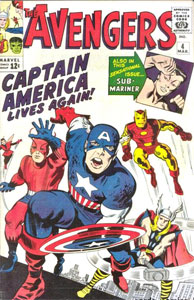 Number 4: Avengers #4
Number 4: Avengers #4
“Captain America Joins…The Avengers!” (Marvel Comics, March 1964)
Before I purchased my copy of Fantastic Four #6 some time ago, my copy of Avengers #4 held the distinction of being the most expensive comic book I had ever purchased. I first read this story many years ago as a reprint that was featured in the book Captain America: The Secret Story of Marvel’s Star-Spangled Super Hero. My elementary school’s library had a copy of this book in their collection and I checked it out many times during my grade school years. During my high school and college years, I was fortunate to have a part-time job working in a local library and one night I snagged an old, beaten up and discarded copy of the “Secret Story” volume out of the library’s garbage. Some time later, when I got my first “real” job, I happened upon an affordable original copy of Avengers #4 and as luck would have it, my new job had provided me with the means to purchase an original copy of the issue.
This issue features the Silver Age resurrection of Captain America by Marvel Comics. Cap’s frozen body is discovered by some natives and worshipped as a god for some time until the notorious Sub-Mariner happens upon them and hurls the entombed Cap into the sea. Cap is later discovered by the Avengers, who thaw him out and learn his true identity. After Cap comes to, he recounts his demise at the hands of Baron Zemo and grieves the loss of his young partner Bucky. As the story unfolds, the revived Cap helps the Avengers battle some gangsters and a mysterious alien. Cap and the Avengers ultimately square off against the Sub-Mariner in a final showdown. Following the battle, Cap is formally invited to join the ranks of the Avengers.
Although some versions of Captain America took on an overly jingoistic and even xenophobic tone at various points (particularly the character’s early exploits in Timely Comics and Atlas Comics and Marvel’s more recent incarnations of the character), the version of Cap from the early 1960’s through the early 1980’s was a dynamic and interesting figure character and he was a great addition to the Marvel Universe.
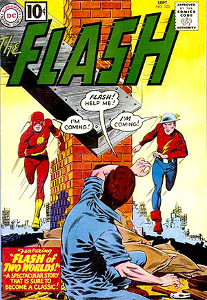 Number 3: The Flash #123
Number 3: The Flash #123
“Flash of Two Worlds” (DC Comics, September 1961)
I was well into adulthood when I finally found an affordable copy of this issue, which is a cornerstone of the DC Universe. As a young comics reader, Barry Allen was my favorite incarnation of the Flash and I also had a fondness for Golden Age characters, so I always wanted to add the first-ever meeting of the Flashes from these eras to my collection. Not only does this story feature Jay Garrick’s first appearance in the Silver Age, but it also constitutes the first mention of Earth Two itself, one of my favorite parallel worlds from DC’s original Multiverse. Although Crisis on Infinite Earths was a monumental story that featured some of my favorite storytelling in comics, it effectively eradicated the heady days of Earth One/Earth Two crossover stories that were launched by this very story many decades ago.
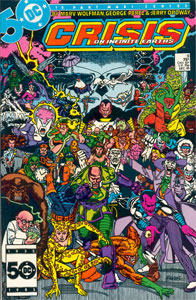 Number 2: Crisis on Infinite Earths #9
Number 2: Crisis on Infinite Earths #9
“War Zone” (DC Comics, December, 1985)
This issue was billed as “The Villain War” in the “next issue” blurb of Crisis #8. It seemed as if it would be a pretty tall order to bring together every surviving villain in the DC Universe for a huge free-for-all, but this issue delivered in a big way. The cover alone is phenomenal (here’s a larger scan), as it crams a ton of the worst villains into one senses-shattering panel. And then, beginning with page 1, it’s pure action. The issue starts with the destruction of Oa and the death of all but one of the Guardians of the Universe. A few pages later, Lex Luthor of Earth-1 murders the Luthor of Earth-2. The issue is a blockbuster that is crammed with the best of DC, including the Teen Titans, Sgt. Rock and many others. There are cameos from the Charlton group, including Captain Atom and Dr. Spectro and a plethora of obscure heroes and villains from the Golden and the Silver Ages. By page 11, Braniac crashes a meeting of the U.N. and announces that the villains have captured three of the remaining Earths: Earths 4, X and S. The rest of the issue features scenes from some amazing battles, including heroes and villains from the Fawcett group as well as the Doom Patrol, Kid Flash and the Flash of Earth-2, the JSA and Infinity Inc. And just when it looks like the villains are on the very brink of total victory, the alliance starts to unravel with Psimon’s betrayal of the Luthor-Braniac alliance. For me, this is where Crisis really came together and picked up momentum. But even by itself, it’s a terrific read!
 Number 1: Last Days of the Justice Society of America Special #1
Number 1: Last Days of the Justice Society of America Special #1
(DC Comics, 1986)
Okay, I will admit that having this book at the top of my favorites list will likely prove to be a head-scratcher for comic fans and non-fans alike. This issue was an instant favorite for me when I got it on my 13th birthday back in 1986 and it has remained at the top of my favorites for close to two decades. The tale is set in the immediate aftermath of the Crisis on Infinite Earths and the overall purpose behind the book was to firm up the legacy of Earth-2 heroes (including the JSA and Infinity Inc.) so that it was in step with DC’s post-Crisis continuity. This 68-page issue has it all, including prominent appearances by most of the heavy hitters in the JSA. How many comic books would begin a story with a quote from Nietzsche? Well, this one does! In the story, the JSAers must travel back to the final days of World War II to wrest the Spear of Destiny from the Nazis. When the Spear is used to trigger the cataclysmic battle of Ragnarök, the JSA must travel to another plane in search of a way to stave off the end of the world. Upon their arrival, they find the gods and goddesses of Norse mythology preparing for an epic battle which will surely mean the end of Earth.
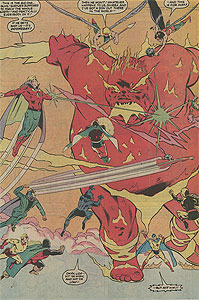 Dr. Fate melds each JSA member with a Norse god or goddess and the JSA then engage the advancing hordes of Surtur, Loki and the Serpent of Midgard in a fierce and brutal battle. The JSA remain joined with the gods and goddesses in a seemingly infinite battle to hold the evil forces at bay and the Nazi attempt to destroy the world by releasing the forces of Götterdämmerung is thus thwarted, allowing the Red Army to smash the remaining German resistance back on Earth. The capture of Berlin is even noted in the tale with a comic-art rendering of Yevgeny Khaldei’s famous photo of a Red Army soldier raising the Soviet flag over the Reichstag. Although the war ends on earth, most of the JSA remain trapped in limbo, engaged in an infinite “Ragnarok cycle” in which the JSAers continue to die and rise again in an endless battle with their foes.
Dr. Fate melds each JSA member with a Norse god or goddess and the JSA then engage the advancing hordes of Surtur, Loki and the Serpent of Midgard in a fierce and brutal battle. The JSA remain joined with the gods and goddesses in a seemingly infinite battle to hold the evil forces at bay and the Nazi attempt to destroy the world by releasing the forces of Götterdämmerung is thus thwarted, allowing the Red Army to smash the remaining German resistance back on Earth. The capture of Berlin is even noted in the tale with a comic-art rendering of Yevgeny Khaldei’s famous photo of a Red Army soldier raising the Soviet flag over the Reichstag. Although the war ends on earth, most of the JSA remain trapped in limbo, engaged in an infinite “Ragnarok cycle” in which the JSAers continue to die and rise again in an endless battle with their foes.
There is a bit of bonus material in this issue, including an introductory/supplemental text by writer Roy Thomas (“An Epilegomena to The Last Days of the Justice Society“) and some vintage Golden Age artwork featuring the JSA. Whew! What a comic book!
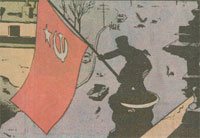 Last Days was written by Roy Thomas who is, in my opinion, one of the best writers to have ever written for DC. The issue’s artwork by Ross and Gustovich is very good as well. I had hoped to include a few more scans of panels from the issue, but the printing quality was not so good and my scans don’t really do the artwork the justice it deserves.
Last Days was written by Roy Thomas who is, in my opinion, one of the best writers to have ever written for DC. The issue’s artwork by Ross and Gustovich is very good as well. I had hoped to include a few more scans of panels from the issue, but the printing quality was not so good and my scans don’t really do the artwork the justice it deserves.
Last Days didn’t exactly stitch up all the holes in post-Crisis/Earth-2 continuity. In fact, the JSA returned to action just a few years later by popular demand. But the story chronicled in Last Days has been revisited several times in the pages of multiple DC series since 1986.
I have read a lot – and I do mean a lot – of comics over the course of nearly three decades and I have enjoyed many classics from the Golden and Silver ages in this time. I won’t deny that I have some sentimental attachment to this particular comic book, but in my opinion, it holds its own with many of the “classics” of the medium. I can’t imagine that I will ever find a story that will take the place of Last Days of the Justice Society on my “Wall of Fame.”




